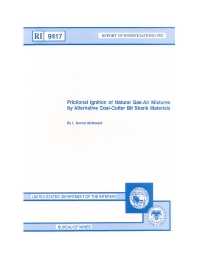Mining Publication: Frictional Ignition of Natural Gas-Air Mixtures by Alternative Coal-Cutter Bit Shank Materials
Original creation date: January 1992
The U.S. Bureau of Mines tangentially impacted potential coal-cutter bit shank materials against sandstone to investigate the potential of the materials to ignite natural gas by a friction-generated hot streak. The shank material samples were mounted in a 24-in, 550-lb flywheel, which was rotated at surface speeds of 400 to 900 sfpm. The sandstone was advanced toward the rotating flywheel at feed rates of 1 mil per impact. The atmosphere mixture was 7 vol pct natural gas in air. Three grades of polycarbonate resin, an ultra-high-molecular weight polyethylene, and a zinc alloy (ZA27) were among the potential materials. None of these materials caused ignition of the methane at any of the three test speeds (400, 600, and 900 sfpm), but the above materials do not have sufficient strength to hold a carbide tip during coal cutting. Of the materials having sufficient strength to hold a carbide tip, three nickel-based alloys proved less likely to cause a natural gas ignition than did iron-based alloys such as 4340 (a commonly used shank material for coal cutters).
Authors: LG McDonald
Report of Investigations - January 1992
NIOSHTIC2 Number: 10011243
U.S. Department of the Interior, Bureau of Mines, Report of Investigations 9417, 1992:1-14
See Also
- The Availability of Primary Copper in Market Economy Countries: A Minerals Availability Appraisal
- Coal-Dust Explosion Tests in the Experimental Mine 1919 to 1924, Inclusive
- History of the Mining Program
- Ignition of Methane-Air Mixtures by Laser Heated Small Particles
- NIOSH Mining Update - New Publications 1995-96
- Pressure Monitoring and Observed Effects of Mining at the Oak Grove, AL, Coalbed Degasification Pattern
- Proceedings of Thru-The-Earth Electromagnetics Workshop
- Propagation of EM Signals in Underground Mines
- Update on the Continuing Functions of the Former US Bureau of Mines
- USBM Health and Safety Legacy Continues Under NIOSH
- Content source: National Institute for Occupational Safety and Health, Mining Program


 ShareCompartir
ShareCompartir
